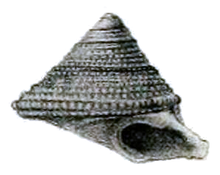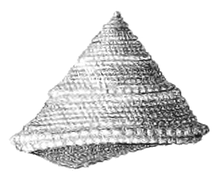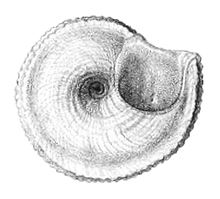- Chytra kirki
-
Chytra kirki 
Color drawing of apertural view of the shell of Chytra kirki shows its dirty whitish appearance Conservation status Scientific classification Kingdom: Animalia Phylum: Mollusca Class: Gastropoda (unranked): clade Caenogastropoda
clade Sorbeoconcha
Superfamily: Cerithioidea Family: Paludomidae Subfamily: Hauttecoeuriinae Tribe: Tiphobiini[2] Genus: Chytra
Moore, 1898[3]Species: C. kirki Binomial name Chytra kirki
(E. A. Smith, 1880)[4]Synonyms Limnotrochus Kirkii E. A. Smith, 1880
Chytra kirki is a species of tropical freshwater snail with an operculum, aquatic gastropod mollusk in the family Paludomidae.[1]
Chytra kirki is the only species in the genus Chytra.[5]
The specific name kirki is in honor of explorer John Kirk (1832-1922), who has donated various other specimen of snails (not this species) to the Natural History Museum.[6]
Contents
Distribution
This species is found in Burundi, the Democratic Republic of the Congo, Tanzania, and Zambia.[1] The type locality is Lake Tanganyika.[4]
Description
The shell is solid, trochiform and dirty whitish in color.[6] The spire is acutely conical.[6] The shell has 6 or 7 feebly concave whorls.[6] They are bearing arcuate and flexuous lines of growth and six or seven granulous lirae, whereof that immediately above the suture is the largest.[6] The body whorl is acutely angular at the periphery, encircled by two subequal granular ridges.[6] The base is concave near the circumference, then slightly convex, concentrically granosely ridged.[6] The ridges nearest the umbilicus are coarser than the others, and also arcuately radiately striated.[6] The shell has deep and narrow umbilicus.[6]
The aperture is irregularly subcircular and whitish.[6] The outer lip (viewed laterally) is obliquely incurved.[6] Basal and columellar margins are forming one strongly arcuate line joined above to the extremity of the labrum by a thickish callosity.[6]
The width of the shell is 19 mm.[5] The height of the shell is 15 mm.[5]
Ecology
Its natural habitat is freshwater lakes.[1] It is widespread[5] species in the Lake Tanganyika, but its distribution is patchy and with low numbers of snails.[1] It lives on the mud with much organic material in depths 10-20 meters.[5][1] There is possibility that it can live in depths up to 80 m.[5][1]
References
This article incorporates public domain text from the reference[6]
- ^ a b c d e f g Nicayenzi F., Ngereza C. & Lange C. N. (2004). Chytra kirki. 2006 IUCN Red List of Threatened Species. Downloaded on 6 August 2007.
- ^ Strong E. E. & Glaubrecht M. (2010). "Anatomy of the Tiphobiini from Lake Tanganyika (Cerithioidea, Paludomidae)". Malacologia 52(1): 115-153. doi:10.4002/040.052.0108.
- ^ Moore J. E. S. (1898). "On the Hypothesis that Lake Tanganyika represents an Old Jurassic Sea". Quarterly Journal of Microscopical Science (N.S.) 41: 303-321. 307. plate 23, figure 6.
- ^ a b Smith E. A. (1880). "Diagnoses of new shells from Lake Tanganyika and East Africa". Annals and Magazine of Natural History (5)6: 425-430. page 426.
- ^ a b c d e f Brown D. S. (1994). Freshwater Snails of Africa and their Medical Importance. Taylor & Francis. ISBN 0 7484 0026 5.
- ^ a b c d e f g h i j k l m Smith E. A. (1881). "On a collection of shells from lakes Tanganyika and Nyassa and other localities in East Africa". Proceedings of the Zoological Society of London 1881: 276-300. Plate 33, figure 18-18b.
Categories:- IUCN Red List least concern species
- Paludomidae
Wikimedia Foundation. 2010.



